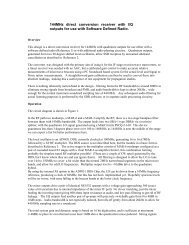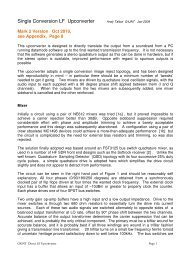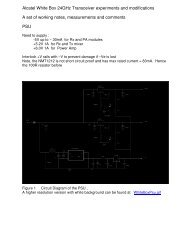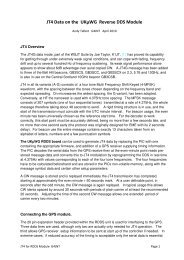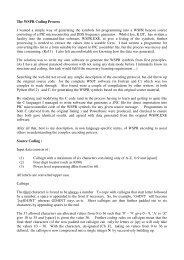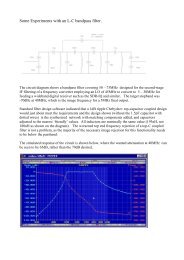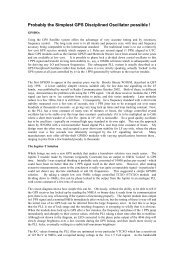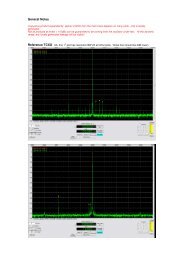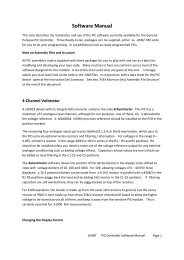LMX2541 Fractional-N Synthesizer Development PCB - G4JNT
LMX2541 Fractional-N Synthesizer Development PCB - G4JNT
LMX2541 Fractional-N Synthesizer Development PCB - G4JNT
Create successful ePaper yourself
Turn your PDF publications into a flip-book with our unique Google optimized e-Paper software.
Power Supplies<br />
The <strong>Synthesizer</strong> chip needs 3.3 V DD supplied by the on-board regulator; current consumption is<br />
approximately 100mA. Input voltage, V IN , can range from 4.5 to 20V. A heatsink is not necessary on the<br />
regulator for input voltages in the lower range.<br />
Resistors R10 – R15 allow the chip to be controlled with 5V logic levels. This allows a PIC to be used with a<br />
V DD suitable for allowing in-circuit programming. Vin to the regulator can be conveniently made equal to this<br />
5V, which is then supplied as one from a second external regulator.<br />
Programming and Getting it Going<br />
The chip’s internal registers have to be programmed to the correct values for your desired frequency and<br />
fractional grid, and the loop gain set, and etc etc etc . The data sheet and an understanding of <strong>Fractional</strong>-N<br />
synthesizers is essential here, but the easiest way to start off is to use National’s CodeLoader software to<br />
work out the values for you. This can be downloaded from the website shown above.<br />
CodeLoader shows a graphical representation of the RF PLL where you can interactively set frequencies and<br />
division ratios, as well as all the other PLL settings.<br />
.<br />
Also select whatever you want from the TP test point on pin 20. Setting this to deliver the divided down N or R<br />
dividers is instructive - it actually supplies a square wave at half the divided down or reference value and can<br />
make a quick confidence check of correct register programming before a complete closed loop system is<br />
established.<br />
Look at the waveform from here on a scope and experiment with programming the R3 register to toggle<br />
between divided down R and N values.<br />
Otherwise, the default registers programmed into the PIC will work as a starting point, but read the data sheet<br />
before modifying registers at will. For most operations, only R0, R1 and R2 need to be set to give a particular<br />
frequency, grid and reference. The other registers can be left alone.<br />
The <strong>LMX2541</strong>_PROG.EXE programme include in the archive allows quick calculation of the registers for<br />
specified values of Fosc, Fout and frequency tuning grid. It can be used in conjunction with a PIC containing<br />
the <strong>LMX2541</strong>CTL operating system as described in the appendix.<br />
PLL Filter Design<br />
The design of PLL filters for <strong>Fractional</strong>-N synthesizers is no different in concept from that for Integer-N<br />
designs, apart from the fact that the reference frequency is usually (a lot) higher with corresponding reduction<br />
in the integer part of N, and usually a higher loop bandwidth. The spreadsheet LMXFILTER.XLS (included<br />
in http://www.g4jnt.com/lmx2541Support.zip ) as shown in Figure 3 lets the basic values for the three<br />
main components forming the first two poles and the optional RC pair for a third pole be calculated. Enter<br />
values the figures highlighted in blue.<br />
The TI website also has loop filter design utilities http://www.ti.com/tool/clockdesigntool<br />
R1 provides for Fastlock operation if desired. See the data sheet for how this is implemented. For most<br />
applications it can be left out.<br />
<strong>LMX2541</strong> <strong>Synthesizer</strong> Module <strong>G4JNT</strong> Page 4



